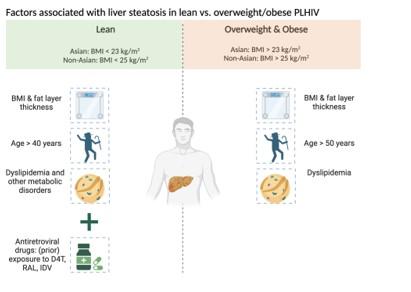Liver steatosis is prevalent in lean people living with HIV and associated with exposure to antiretroviral treatment – a cross-sectional study
Louise E Van Eekeren, Nadira Vadaq, Wilhelm A J W Vos, Marc J T Blaauw, Albert L Groenendijk, Jan Van Lunzen, Janneke E Stalenhoef, Marvin A H Berrevoets, Annelies Verbon, Gert Weijers, Mihai G Netea, André J A M Van Der Ven, Quirijn De Mast, Leo A B Joosten, Eric T T L Tjwa
Background
Steatotic liver disease is suggested to have a higher prevalence and severity in people living with HIV (PLHIV), including in those with a normal BMI. In this study, we used data from the 2000HIV cohort to (i) assess the prevalence of liver steatosis and fibrosis in lean versus overweight/obese PLHIV, and (ii) assess associations in these subgroups between steatosis and fibrosis with traditional risk factors and HIV-specific characteristics.
Methods
The 2000HIV study cohort comprises 1895 virally suppressed PLHIV that were included between 2019 and 2021 in four HIV treatment centers in the Netherlands. The majority (58.5%) underwent vibration-controlled transient elastography for the assessment of liver steatosis and fibrosis. The prevalence of steatosis (controlled attenuation parameter [CAP] ≥ 263 dB/m) and fibrosis (liver stiffness measurement [LSM] ≥ 7.0 kPa) was estimated. Multiple factors including HIV-characteristics and antiretroviral drugs were tested in a logistic regression model for association with steatosis and fibrosis. Analyses were performed separately for lean (Asian descent: BMI < 23 kg/m2, other descent: BMI < 25 kg/m2) and overweight/obese (other BMI) participants.
Results
Of 1050 PLHIV including 505 lean and 545 overweight/obese PLHIV, liver steatosis was observed in 37.7% of the overall study population, 19.7% of lean and 54% of overweight/obese PLHIV, while fibrosis was observed in 9.0% of the overall study population, 5.9% of lean and 12.0% of overweight/obese PLHIV.
All associations with fibrosis and most associations with steatosis concerned metabolic factors such as T2DM (overall population: adjusted odds ratio [aOR] for steatosis: 2.3 [1.21–4.4], p-value = 0.011; aOR for fibrosis: 3.7 [1.82–7.53], p-value < 0.001). Furthermore, in lean PLHIV, liver steatosis was associated with CD4 and CD8 counts at enrollment, dual therapy, and history of treatment with raltegravir (aOR: 3.6 [1.53-8.47], p-value = 0.003), stavudine (aOR: 3.73 [1.69-8.2], p-value = 0.001), and indinavir (aOR: 3.86 [1.59-9.37], p-value = 0.003). These associations were not observed in overweight/obese PLHIV.
Conclusion
Liver steatosis was highly prevalent, affecting approximately one-fifth of lean PLHIV and half of overweight/obese PLHIV. Fibrosis was observed in a minority. Both steatosis and fibrosis were associated with traditional metabolic risk factors. In addition, (prior) exposure to specific antiretroviral drugs was associated liver steatosis in lean, but not in overweight/obese PLHIV. Implementing increased screening protocols could enhance the identification of steatotic liver disease in lean PLHIV.
Graphical Abstract

